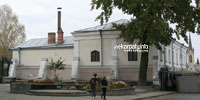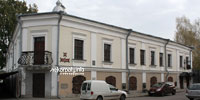The Lesya's Living Room
The memorial museum 'Lesya's Lvivng Room' is located on the first floor of a historical building (late 18th century), which had a rich history with many owners and institutions placed inside. In 1890-1891 in its western wing, first floor, was the office of the local conciliator Petro Kosach (father of Lesya Ukrayinka), and opposite was his corporate apartment. From 1985 the building is under control of the administration of the State Historical and Cultural Reserve. 'Lesya's Living Room' was founded in 2007 in the eastern wing of the building. Behind the museum opening lies the idea that Lutsk was the place where a young child Larysa Kosach, who became a famous poet Lesya Ukrayinka in the future, wrote her first poem called 'Nadiya' (the Hope).
The exposition is designed not in the form of traditional glazed windows, but like a real life house — you can look at yourself in the mirror, sit at the desk, play the piano or hold a book straight from the times of Lesya Ukrayinka. The staff having worked on the exposition succeeded in recreating the authentic atmosphere of the house belonged to an educated Ukrainian family of the late 19th century, which happened as a result of making right choices in furnishing and decorating the exposition.
One thing that can definitely draw your attention is the collection of old photographs in the hallway. Those are the images of the castle, its walls and towers, pictures of the old church (where the future poet enjoyed listening to the pipe organ) and the old city, how they looked like when Lesya Ukrayinka lived in Lutsk.
The living room is the main place of the exposition. The exhibits displayed there are old furniture and authentic photographs of the poet's parents and relatives (grandmother, aunts, children of the family). All the pictures were taken not later than May, 1891. The remarkable object there is also a piano: the house was the exact place where the aunt Sasha started teaching young Larysa playing the instrument (1880). And in December, 1890, she writes to M. Drahomanov: 'I sometimes think that I'd have made a much better musician than a poet...' The room is planned to be made a place for cultural events in honour of the poet. You will be able to get acquainted with her poetry, listen to the songs made with her lyrics and also to her favourite musical works.
The very last room of the exposition is a dining room where the whole family gathered at the table with a samovar (a type of heated metal piece for boiling water to make tea). It was traditionally a place for family meetings and discussions. Now, not least because of the efforts put by the staff into organizing the space in the right way, the visitors can see the authentic interior from the late 19th century.
Drahomanov St., 23
Tel.: +38 (0332) 72-53-71
Go by train or by bus to Lutsk city. The museum is located within Lutsk castle.
More information about public transport.
By car
In Lutsk, go till the beginning of Volia Avenue (ukr. — Prospekt Voli), then go along B. Khmelnytsky—D. Halytsky street untill the left turn to Bratkovsky street. From there, turn to Kafedralna street (the second left turn). The building you need is located at the corner of Kafedralna and Drahomanov streets.

 Ukraine
Ukraine Poland
Poland Slovakia
Slovakia
 Українською
Українською






